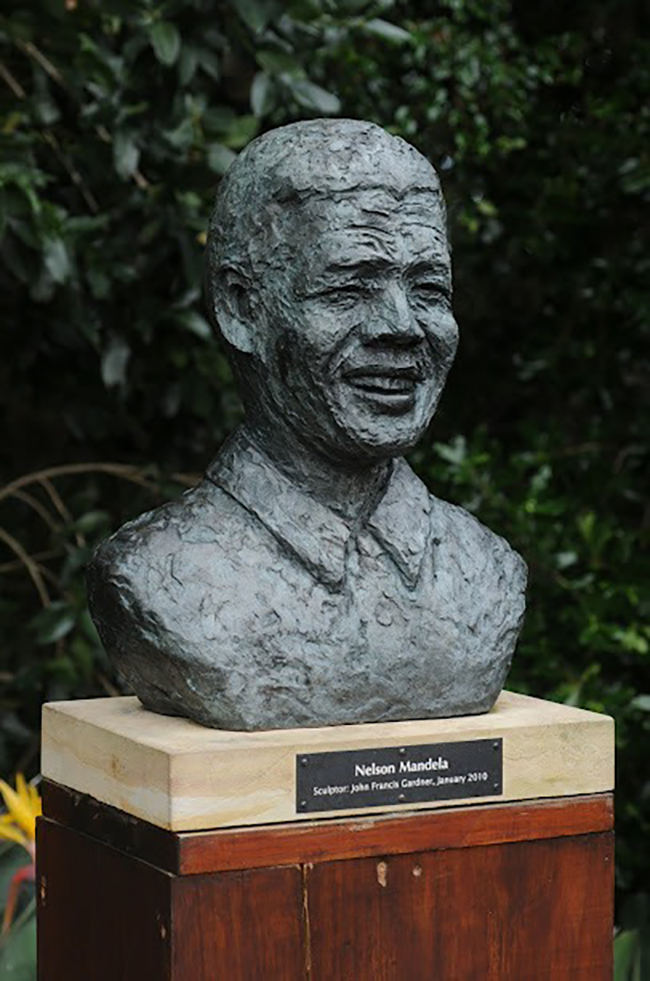John Gardner’s journey into sculpture is as textured and layered as his bronzes. He is a storyteller with clay and metal, capturing more than just the physical likeness of his subjects. His sculptures radiate warmth and humanity—qualities he believes history should remember alongside the achievements of remarkable individuals.

In 2006, Gardner sculpted a bust of Nelson Mandela, despite the former South African president’s initial refusal to sit for the artist. “When Mandela said he was too old and properly retired, I told him I would create a bust of him at the age I thought he looked best,” Gardner recalls. The bronze bust was sent to the Nelson Mandela Foundation in Johannesburg. Months went by with no word from Mandela, prompting Gardner to check in with Verne Sheldon Harris, Mandela’s archivist.
“Have you spoken to Madiba about the bust?” Gardner asked. Harris’ response was unexpected but heartwarming: “No, I haven’t spoken to him, but I’ve seen him standing in his doorway, smiling at it. What does that say?” That image—Mandela quietly admiring the sculpture—sums up Gardner’s intent: to create pieces that resonate on a deeply human level.
The Mandela bust is part of Gardner’s “Legends of Africa” series, which began with a bronze of Archbishop Desmond Tutu. The series continued with other influential figures, including Dame Helen Suzman, former President FW de Klerk, actor Dr. John Kani, and environmentalist Dr. Ian Player. Gardner’s goal with this series was clear: “I wanted these people to be remembered not as cold, unsmiling bronzes, but as sculptures that radiate character, love, warmth, and life. I call them ‘Living Bronzes.’”
Gardner’s connection to Mandela predates the “Legends of Africa” series. In the mid-1980s, while serving as Chairman of the Quaker Peacework Committee in Cape Town, Gardner became aware that Mandela, still imprisoned at the time, was concerned about his grandchildren’s education. Determined to help, Gardner embarked on a journey to interview Mandela’s family members, even facing arrest along the way. High-level intervention secured his release, and he was able to provide the feedback Mandela sought.
In 2010, Gardner sculpted another Mandela bust, this time depicting the leader at an older age. It was intended for the courtyard of Robben Island prison, where Mandela once exercised. However, political circumstances prevented the bust from being placed there. Instead, it found a new home at Kirstenbosch Botanical Gardens in Cape Town. Perched on a Table Mountain sandstone pillar near the entrance, the bronze now greets visitors with a smile.
Gardner’s fascination with capturing human likenesses in bronze began in 1978 when he was a young doctor at Groote Schuur Hospital in Cape Town. Inspired by Professor J.H. Louw, a medical pioneer, Gardner asked if he could sculpt the professor. Louw agreed, motivated by a desire to avoid being sculpted by the same artist who had created a bust of his former student, heart transplant surgeon Professor Christian Barnard. Gardner’s resulting sculpture, cast from 70 kilograms of clay, was displayed for many years at the Red Cross Children’s Hospital in Cape Town.
Gardner’s sculptures are more than artistic representations; they are tributes to individuals who have shaped the world for the better. He chooses his subjects carefully, focusing on those whose lives have had a positive impact. His bronzes capture not just physical features but also the essence of the person—their energy, warmth, and humanity.
Beyond his work with public figures, Gardner also accepts private commissions. His figure sculptures highlight what he describes as “the extraordinary beauty of the human form.” His approach is always the same: to find the humanity in his subjects and convey it through his art. Gardner’s process involves a deep connection with the subject, whether he is sculpting someone he has met or interpreting their essence through photographs and stories.
Gardner’s bronzes have a timeless quality, inviting viewers to reflect on the humanity of his subjects. They are not static relics but dynamic representations of people who have lived, loved, and left their mark on the world. His work bridges the gap between history and emotion, reminding us that great individuals are remembered not just for their achievements but for their character and spirit.
Through his sculptures, John Gardner has created a lasting dialogue between past and present. His “Living Bronzes” stand as reminders that the people who shape history do so with humanity, compassion, and resilience—qualities that Gardner captures with every curve of clay and cast of bronze.

